Results 131 to 140 of 185
Thread: Learning Jnats with Microscope
-
05-15-2021, 06:32 PM #131
-
05-29-2021, 04:34 AM #132Senior Member

- Join Date
- Sep 2020
- Location
- Austin, TX
- Posts
- 653
Thanked: 56
-
05-29-2021, 09:32 AM #133
 I know that I don't know (Socrates)
I know that I don't know (Socrates)
-
05-30-2021, 08:16 AM #134
 Honing the NOS.
Honing the NOS.
Here I am again bros!

After a year (more or less) I saw the first honing stone, and a lot of experiments with cheap vintage SRs, yesterday I decided it was time to put my hands on a New (and more expensive) one. In fact, having shaved 4 times with the factory's honing, my NOS New Star (Japan) needed to be to finally honed properly.
On the strength of the experience gained so far, I decided to use my "usual" sequence of three nagura on Nakayama Kiita Koppa as base stone, but this time I wanted to test the slurry produced by a Blue Escher Tomo as a final one. So the sequence was: Tsushima - Asano Mejiro and Blue Escher. Used one Kapton layer to protect the spine.
As you can see from the images, the original bevel was very narrow and I'm glad I managed to contain its enlargement while sharpening.
Microscopic results sems (to me) quite good and the Blue Escher quite fine, i.e. more or less as the Mejiro (?). Treetop test easily passed.
Today, when shaving, the razor performed very well. It was close and well gliding. I felt it just a bit too aggressive on the skin (itchy after alcolic AS), but I'm sure it will go better after some more stropping. Btw I've another NOS japan razor finished by the vendor on a blue-green Escher and it was quite aggressive too on the first 2/3 shaves.
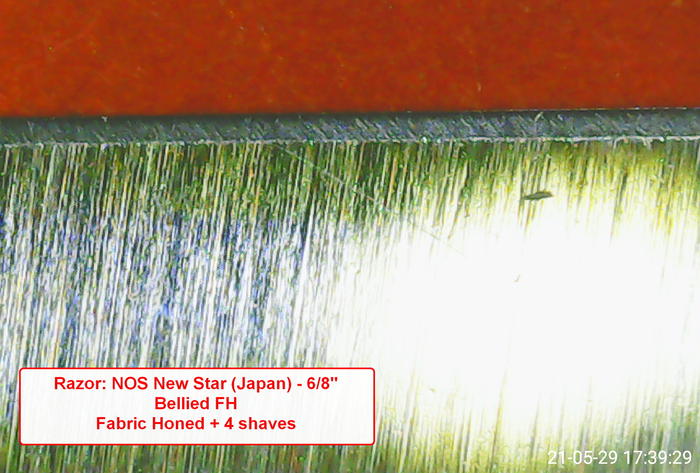
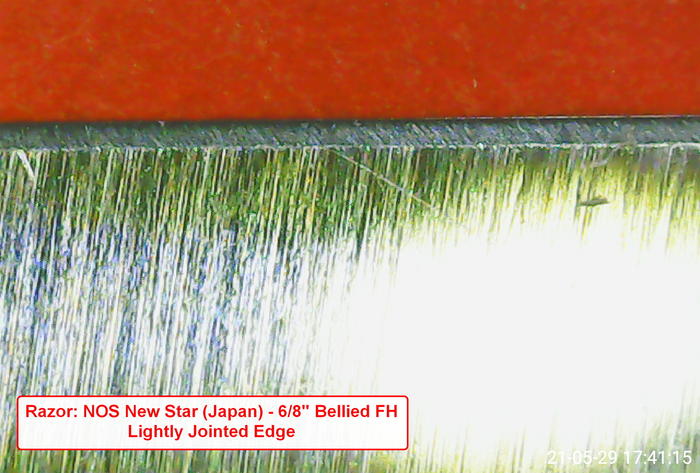
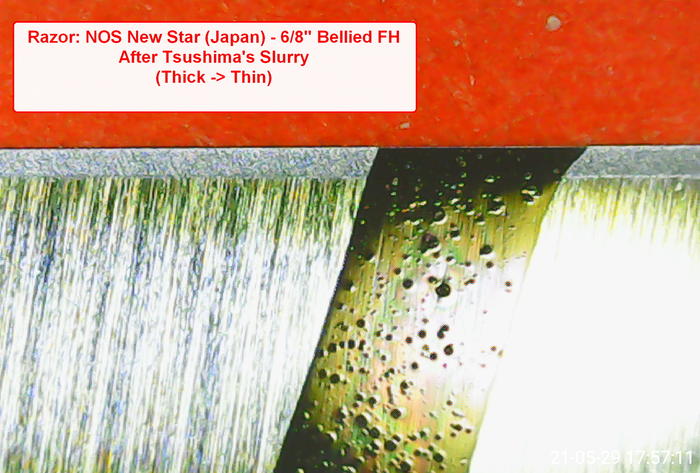
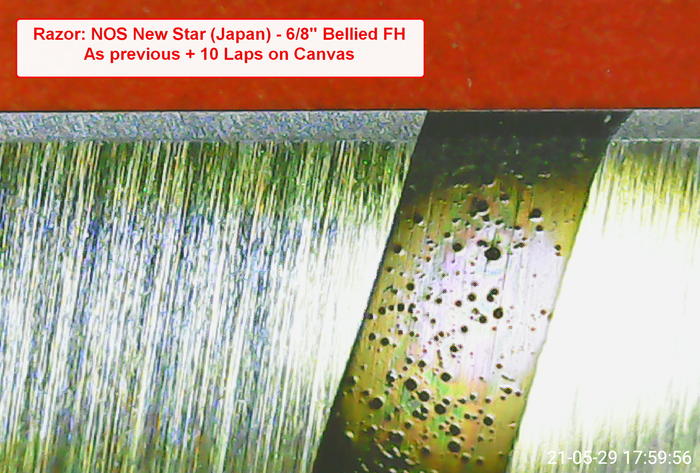
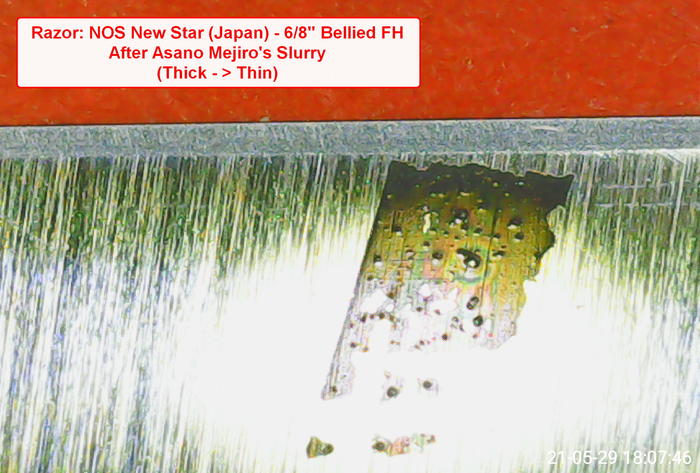
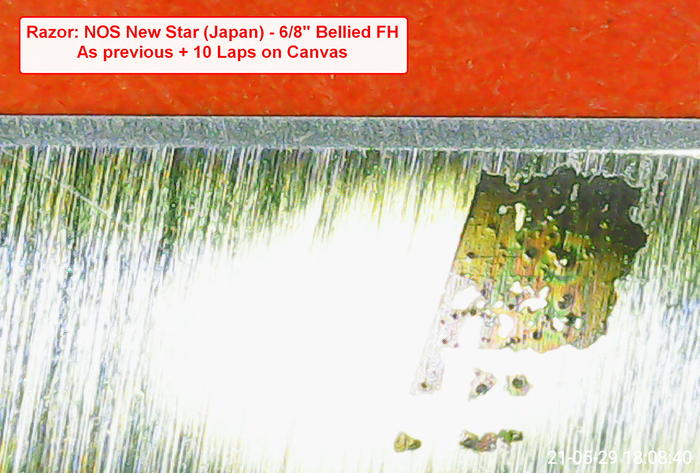
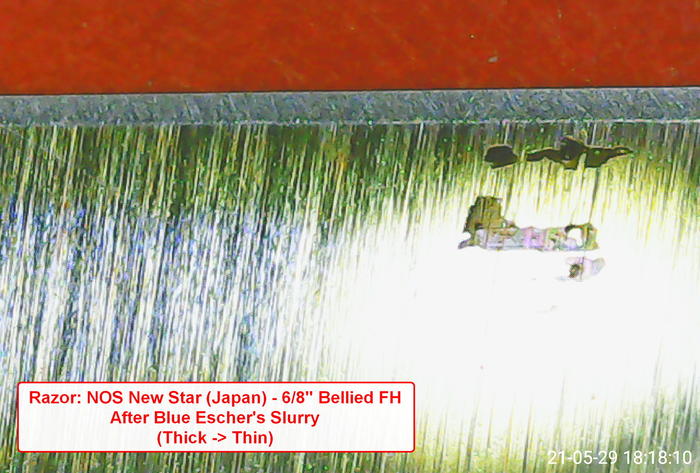
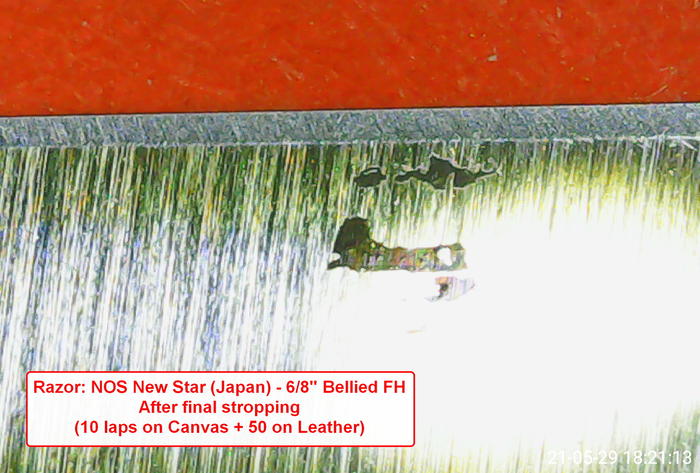 I know that I don't know (Socrates)
I know that I don't know (Socrates)
-
05-30-2021, 02:57 PM #135Senior Member



- Join Date
- Apr 2012
- Location
- Diamond Bar, CA
- Posts
- 6,553
Thanked: 3215
As I have watched your honing progress through all the slurries and problematic razor edges, I have wondered what you could do with a razor with a good grind and good steel.
The original edge, though nicely honed, appears to have a bit of a burr/flashing, which could produce a harsh shaving edge. Jointing removed it and further straightened the edge nicely.
The bevel and edge look very nice and straight after Tsushima slurry. It appears the finish on the bevel with Escher slurry was not as consistent as Jnat slurry, (something I have noticed prior), but the edge looks straight. Also, something I have noticed. The bevels do not need to look pretty to shave well.
A shave test between the Escher finish slurry and your best Nagura should be interesting.
Nice razor and nice work.
-
The Following User Says Thank You to Euclid440 For This Useful Post:
Skorpio58 (05-31-2021)
-
05-31-2021, 06:01 AM #136

Euclid... I agree. Like how the bevel looks after Tsushima (and not just this time). Have to test it on shave one of these days.

Rather I am wondering if the Mejiro before a Tomo is useful or not? In fact, during the comparative shave tests I'm doing, I use a Tomo right after the Tsushima and get good shaves. What if I did the opposite (Mejiro after Tomo)? As the Mejiro is known as a finisher in Asano's sequence (apart for the discussion about Koma). Or stop at Mejiro after Tsushima instead of adding a Tomo? Or could it be a matter of Slurry's technique (density, diluition, time, pressure)?
One first answer should come from next shave... as I have added a "Mejiro only" after Tsushima to the comparative test, and tomorrow will publish the results.I know that I don't know (Socrates)
-
05-31-2021, 03:03 PM #137Senior Member



- Join Date
- Apr 2012
- Location
- Diamond Bar, CA
- Posts
- 6,553
Thanked: 3215
So, remember that all Nagura are natural stones and performance can and will vary from stone to stone. from Nagura to base stone combination, and even from Nagura, base stone… and steel combination.
The purpose of the initial test was to rank your Nagura, used with your hand on your base stones, so you would have your own personal progression and Nagura ranking.
What we saw was, there is very little difference in most stone’s performance visually. And the deciding factor may be for you, the shave.
Now on the other hand, I look at it similarly to producing a pristine satin finish. The way the experts at this finish do it is, to take a blade to a high, black mirror finish, (remove all the imperfections in the steel) then introduce a lower grit, (usually clean 600 wet & dry or Crocus to lay down an even mat satin stria pattern. (Look at some of Mike, Wolfpack34’s satin finish on Sheffield razors or the Bowie Knives of Nick Wheeler).
Part of what make their satin finish so uniform and lightly matted is the flawless mirror base that the satin stria is laid upon. In essence you may be doing the same thing. On the other hand, what we are after is the edge and how it shaves, so the shave is what counts.
When I go to a natural stone as a finisher I do so after an 8k that leaves a near mirror bevel and super straight edge. I believe that doing so allows me to lay down a unique Jnat edge on a blank canvas. So, finishing on a “higher”, smoother producing grit is doing much the same thing.
Personally, I feel that some of my Tomo are finer or better said can produce a finer edge than the Mejiro and Koma I have, but it is not like a 1k -8k difference, it is very subjective, and technique driven.
-
The Following User Says Thank You to Euclid440 For This Useful Post:
Skorpio58 (06-01-2021)
-
06-01-2021, 08:30 AM #138
 Second Comparative Nagura Test - Round Five.
Second Comparative Nagura Test - Round Five.
As anticipated, the other night I continued my series of Nagura comparison tests on my Ozuku Asagi Koppa. This time, after the Tsushima's slurry, I went directly on the Asano Mejiro's.
Images shows the bevel aspect and expecially how the pitting spot appeared during the second round, finally broke into the edge causing a second micro-chip (see this Post for dimensions).
Note: the razor came fro the stropping test described Here.
Anyway, despite that, today I got one of the closest (and smooth) shave ever, and the presence of the micro-chips was unnoticeable.
One of the reasons could be the repeated use of the Tsushima, which has remarkable sharpening abilities, as well as those of erasing the sharpening marks due to the stones of lower Grit. I.e. as the tests add up, the blade becomes sharper and sharper.
The mejiro, for its part, while not showing the finest aspect, still seems sufficient to ensure a good and smooth finish ... at least in practice.
Next move will be using a very fine Tomo (Ozuku Suita or the Asagi) on this bevel, and see if it adds something to the shave.
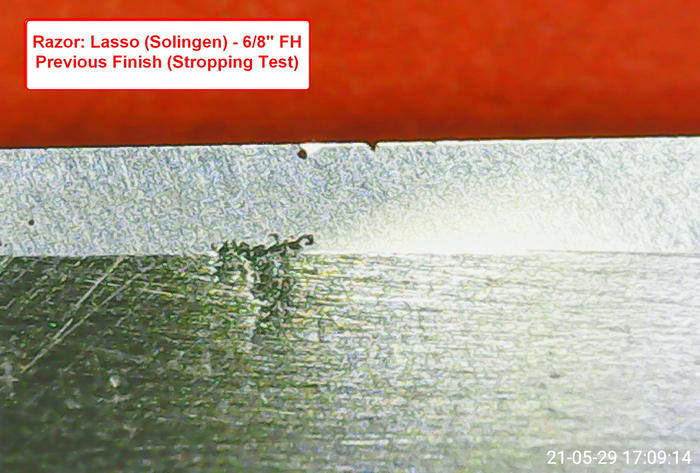
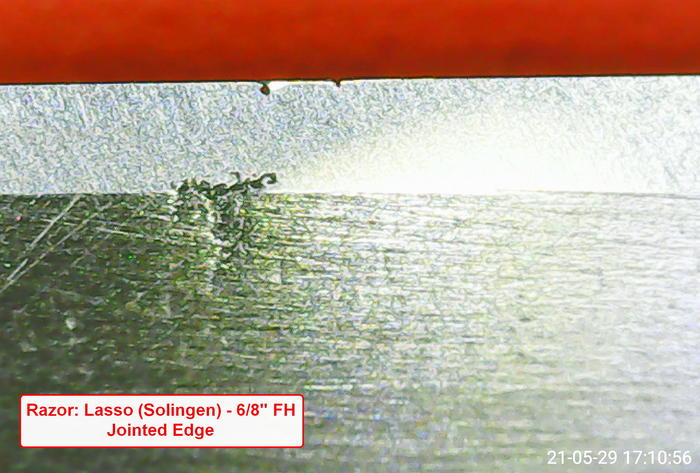

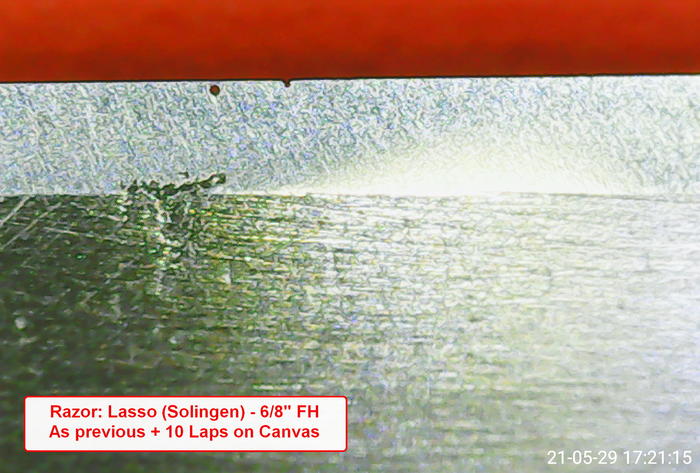
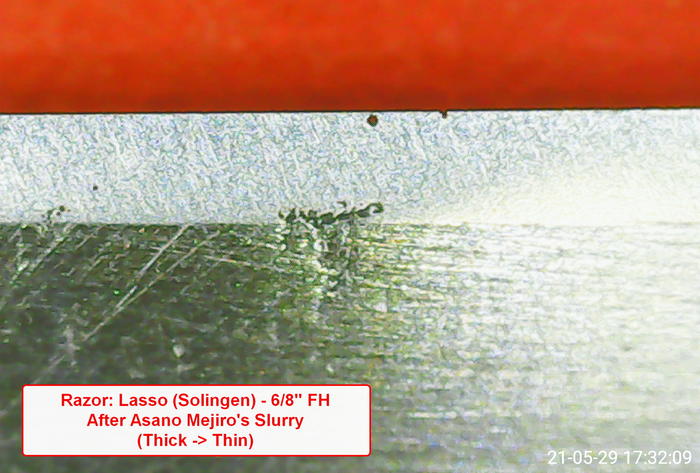
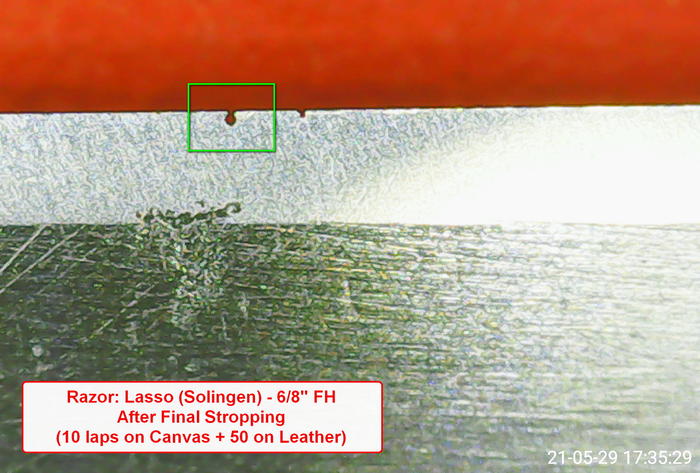
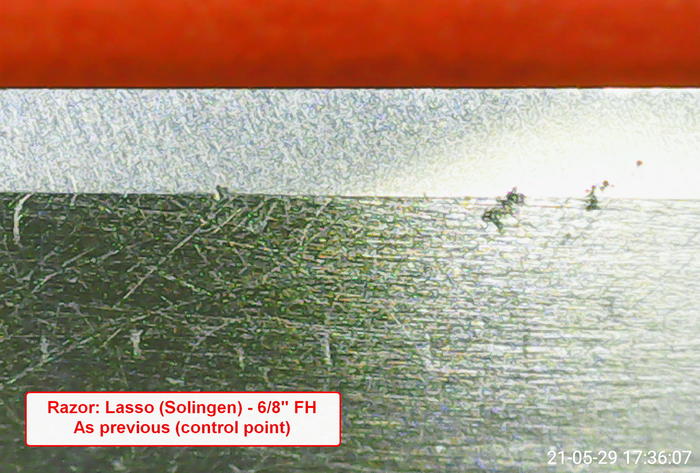 I know that I don't know (Socrates)
I know that I don't know (Socrates)
-
06-07-2021, 10:20 AM #139
 Update.
Update.
As I wrote in my previous post (Above) I finished the razor with Ozuku Suita's slurry. Didn't took micrographs as we all know well, by now, how it shows after the Mejiro on my Ozuku Asagi base stone. Also, next time I'll use in the sixth round of the comparative series and will take more photos
The shave performed very well, maybe just a little bit smoother and closer than Mejiro's only, but these really are almost negligible differences. Both of a very high standard.I know that I don't know (Socrates)
-
06-07-2021, 02:33 PM #140Senior Member



- Join Date
- Apr 2012
- Location
- Diamond Bar, CA
- Posts
- 6,553
Thanked: 3215
Tsushima can be aggressive, even more so than Botan. Depending on the slurry thickness and pressure, you can remove some steel fairly quickly.
The other day I touched up two of my razors, they were shaving fine but not as smooth as freshly honed. I took one, a Filarmonica, to Tenjo slurry and it cleaned up nicely, and finished well with a hard Asagi slurry on a clean Ozuku Asagi stone producing a verry smooth, straight, and keen shaving edge.
The other had a couple microchip, not surprising, it was an Antique store find, a 7/8th, heavy, Romer, that had a rough edge and in need of some cleanup when I bought it. It honed up nicely and I had been shaving with it for a couple months but started to not shave as smoothly but still shaved well.
A quick look under magnification revealed the micro chipping and a few imperfections on the edge. I took that one straight to a thickish Tsushima slurry that quickly removed the microchips and once thinned, the slurry straightened the edge nicely. A Tenjo slurry refined the bevels and edge and finished on the Asagi producing a fine shaving edge.
So, a Tsushima slurry can be aggressive when thick and with pressure but can also finish a bevel nicely when thinned and worked, but the bevels and edge can be refined even more with finer slurry producing Nagura.
I find the Tenjo, and Tsushima are both aggressive and polishing depending on the level of edge repair needed, but are good touch up nagura, when that is all that is needed.
I find that refreshing on slurry is easier on an edge, that a synthetic and synthetic edges can microchip. Slurry touch up are less edge damaging and may produce a slightly stronger edge without the deep stria from aggressive synthetic stones. And they can be almost as aggressive in terms of time spent on the hones. I probably spent 20-30 minutes on each razor.
-
The Following User Says Thank You to Euclid440 For This Useful Post:
Skorpio58 (06-07-2021)


 211Likes
211Likes LinkBack URL
LinkBack URL About LinkBacks
About LinkBacks








 Reply With Quote
Reply With Quote